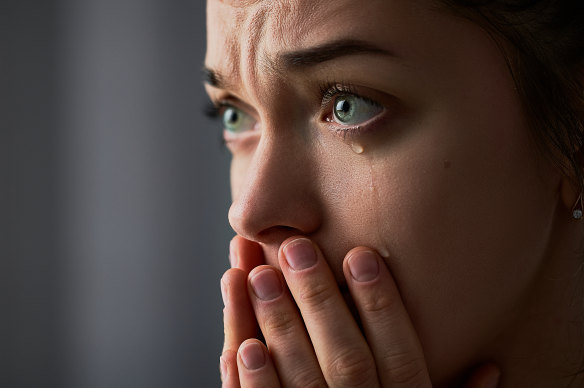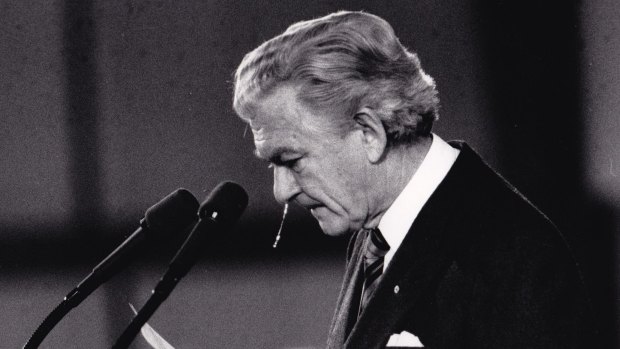Opinion
The first time I saw crying that frightened me, it came from my father
Jacinta Parsons
Writer and broadcasterThe first time I saw crying that frightened me, it was a Wednesday in 1983. I heard it before I saw it. My dad’s enormous body producing something, until then, I hadn’t known. Not like this. His howl shook the windowsills. It was the day of the Ash Wednesday bushfires, when the farm he grew up on was razed.
I hadn’t understood that a body was capable of expressing pain this way. My child’s body hadn’t registered anything like it. I hadn’t seen many men cry before.

Crying has historically been frowned upon, but it is often our path to healing.Credit: Getty Images
It wasn’t the best time for the activity of crying in the decades leading into the ’80s. There seemed a collective pop-cultural conspiracy against it. In the ’60s, The Four Seasons were unequivocal in their stance with Big Girls Don’t Cry, and Conway Twitty suggested that Joni also resist the urge with Don’t Cry Joni in 1975. The Cure dropped Boys Don’t Cry on the eve of the ’80s, and Prince confused the situation further a few years later by suggesting screaming at each other sounded like doves crying.
Our aversion to crying, particularly in front of others, has been built into our fabric. Most of us were encouraged from a young age not to cry if we could help it. And if we did cry, there was an undercurrent of judgment that we had been weak to have surrendered to it. But it is a very strange cultural aversion because crying is the release, the articulation – it is the way we find our way back home.
There are myths that suggest statues of saints have produced tears – perhaps suggesting that even the most holy might make the ultimate expression of the human spirit to find a way, against all odds, to feel what it is to live. Is the question we ask about crying, “When was the last time you did it?” really asking, “When was the last time you surrendered to being human?”
English falls short to explain the complexity of why we cry. Why we should cry.
I cried when I gave birth, and when I lost a pregnancy and when Geelong won the 2007 grand final. I cry when I fall in love and when I eat a really good dim sim. It might look the same, but it is born within us for such complex reasons (South Melbourne versus supermarket bullet in the case of the dim sim).
I cry when I understand beauty, and pain. Recently, at a loss, I cried so that my insides could find their way out of me and find some relief from its pain.
And we are afraid of how ugly it is and how we are distorted under its influence. The “ugly cry” is its own subgenre, where we become snot and howls and mutation. The “ugly cry” leaves us incapable of influencing its presentation. And we are loath to do it. To expose ourselves with abandon.
Maybe our aversion to others’ tears is actually born of our deep compassion. We understand how painful it is to release something and we are impotent to console. We are frightened to live in these bodies that can feel so much.

Bob Hawke, delivering an emotional speech at a memorial service for victims of the Tiananmen Square massacre in 1989, offered asylum to Chinese students in Australia.Credit: Graham Tidy
It’s particularly hard for men, still, to cry in public – unless it is for a sporting win. Bob Hawke cried after the Tiananmen Square massacre. It might have been to show us that power and humanity can coexist. We are still unsure of what it means to be a man and to show the vulnerability of surrender and to not have to prove a mastery over the human condition.
But I hope we are getting better at resisting the urge of The Cure’s refrain. And that we are well on the way to teaching our little boys that crying is an act of humanity and of connection and of powerful vulnerability. I hope we are committed to help them understand that this is our way to allow the world to flow through us, to not have any of it trapped inside. Even when we might like to live there forever, like the Geelong win of 2007.
I have been practising being better at being in the company of others crying. Reminding myself not be frightened of it, as I was when I was a child. And to be braver to cry when it arrives in me, to show my children that nothing is broken when we cry, and in fact, it is about going home.
Jacinta Parsons is a Melbourne writer and co-host of The Friday Revue on ABC Radio Melbourne.
The Opinion newsletter is a weekly wrap of views that will challenge, champion and inform your own. Sign up here.